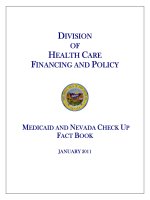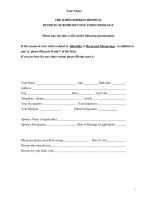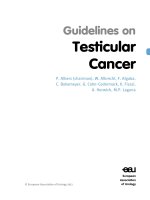Genetics and Testicular Cancer: Division of Cancer Epidemiology and Genetics Clinical Genetics Branch doc
Bạn đang xem bản rút gọn của tài liệu. Xem và tải ngay bản đầy đủ của tài liệu tại đây (1.59 MB, 45 trang )
Genetics and Testicular Cancer
Division of Cancer
Epidemiology and Genetics
Clinical Genetics Branch
7/12/05
Tentative Schedule of Visit
1. Description of
the research aspects
of the study
2. Signing the
informed consent
document, to
formally enroll in
the family study
3. Genetics and
testicular cancer
education
4. Medical
evaluations
5. Specimen
collection
9
9
Testicular Cancer: What We Know
R Accounts for ~1% of all cancer in men
R Incidence of testicular cancer is on the rise
R Most frequent in Northern Europe and North
America
R ~ 9,000 new cases in US in 2004
R Incidence varies with ethnic background (blacks at
lower risk than whites)
R The first step in the process that leads to testicular
cancer probably occurs during pregnancy
R Tumors begin to appear during adolescence
Testicular Cancer Risk Factors
R Sex - male
R Age - 15 to 35
R Race - Caucasian
R Family history
R Prior testicular cancer
R Infertility
R Undescended testicle
(cryptorchidism)
R Inguinal hernia
R Abnormal
development of testes
R HIV/AIDS
R Carcinoma-in-situ
R Klinefelter syndrome
Testes Development
R Testes develop adjacent to the kidneys
and from the same tissue in the fetus
(therefore, it is possible that abnormalities
of the kidneys may be found in males with
testicular cancer)
R Testes descend into the scrotum through
the inguinal canal
R Undescended testicles (cryptorchidism)
occurs in 3% of full-term and 30% of
premature deliveries
Adapted from: - Chapter 27 - Figure 27-3
Mature Male Urogenital System
(vas)
/>Pubic
Genes
R What are genes?
R Where are they located?
R How do they work?
R What happens when they
don’t work?
What are genes?
R A small bit of DNA that contains the
information needed to make a protein
R Proteins are what tell our cells how to
function
R Genes are inherited from our parents
R Genes can be passed on to our
children
U.S. Department of Energy Human Genome Program />Where are the genes located?
R Our bodies are composed of organs
and tissues
R Organs and tissues are made up of
many cells
R Cells contain chromosomes
R Chromosomes come in pairs (one
from each parent)
R Each chromosome contains thousands
of genes (like beads on a string)
R Genes make proteins
R Proteins tell our cells what to do:
grow, divide, secrete hormones, etc.
/>ASCO
Chromosomes, DNA, and Genes
Chromosomes
Cell
Nucleus
Adapted from Understanding Gene Testing, NIH, 1995
Gene
Protein
Chromosomes Come in Pairs
How You Get Your Genes
Adapted from: Essential Cell Biology, Chapter 9, Figure 9-34, ©1998 by Alberts, Bray, Johnson, Lewis, Raff, Roberts, Walter .
Published by Garland Publishing, a member of the Taylor & Francis Group.
The DNA Double Helix
Adenine (A)
Thymine (T)
Cytosine (C)
Guanine (G)
Bases
Sugar
phosphate
backbone
Base pair
ASCO
The DNA Double Helix and the
Genetic Code
Bases
Sugar
phosphate
backbone
Base pair
ASCO
ATT ATG AGT AAC CCA
Isoleucine - Methionine - Serine - Asparagine - Proline
ASCO, modified 12/02
Disease-Associated Mutations
Alter Protein Function
Functional
protein
Nonfunctional or
missing protein -
deleterious mutation
Functional
protein -
polymorphism
The Development of Cancer Depends
on Multiple Genetic Changes
“Sporadic” Mutations
R Mutations in testicular cell cause cancer
R Both mutations occur in target organ
R Causes cancer later in life
R Mutation cannot be passed on
X
Offspring
ASCO, modified 1/03
Parent Parent
Genetic “hit” or mutation
Parent
Inherited mutations =
“Hereditary Cancer”
ASCO, modified 1/03
R
All cells have mutation from birth
R Second mutation permits cancer
R Mutation passes through egg/sperm to some offspring
Genetic “hit” or mutation
Parent
Parent has
mutation
present in
all cells of
the body
Offspring
inherits first
mutation
from parent
and may get
second “hit”
leading to
testicular
cancer
Offspring
Possible Inheritance Patterns
R Autosomal Dominant
R Autosomal Recessive
R X-Linked Recessive
ASCO
Inheritance from Your Parents
Alleles: variant forms of the same gene (A a)
A a
a a
A a a aA a a a
ASCO, modified 12/02
Autosomal Dominant Inheritance
R Each child of a person with a mutation has 50% chance of
inheriting the mutation
R Even though the cancer may appear to “skip generations,” the
mutation does not. This occurs because not everyone with a
mutation will actually develop cancer.
R Equally transmitted by men and women
Normal
Affected male
Unaffected female
mutation carrier
Autosomal Recessive Inheritance
Non-carrier individual
Non-affected carrier
“Genetically affected” female
Affected male
R Family members with one copy of the abnormal gene appear to be healthy.
They are called “carriers.”
RMales who inherit two germline mutations (one from each parent) are at risk
of developing testicular cancer
R Females, in this example, may have two abnormal copies of the gene, but
they cannot get the disease, because they lack the critical target – they are
“genetically affected,” but clinically normal, females.
R Equally transmitted by men and women
ASCO, modified 12/02
ASCO, modified 12/02
X-Linked Recessive Inheritance
Carrier female
Affected male
Normal male
R The mutated gene is on the X (sex) chromosome
R
1
Females who carry a mutation :
R Half (50%) of their sons will inherit the mutation and be at increased risk of
developing testicular cancer;
R Half (50%) of their daughters will inherit the mutation, and they will be carriers.
R
2
Males who carry a mutation (whether or not they have cancer):
R All of their daughters will inherit the mutation;
R NONE of their sons will inherit the mutation.
R Females or males who do not inherit a mutation cannot pass it on to their children.
1
12
11
2
2
The Genetics of Testicular Cancer
ASCO, modified 12/02
The Human Genome and Cancer
R The Human Genome Project is helping us to
discover new cancer genes and to develop:
R Predictive tests to identify genetic predisposition
R Diagnostic tests to detect cancer in its earliest
stages
R Treatments that target gene abnormalities in
cancer cells









